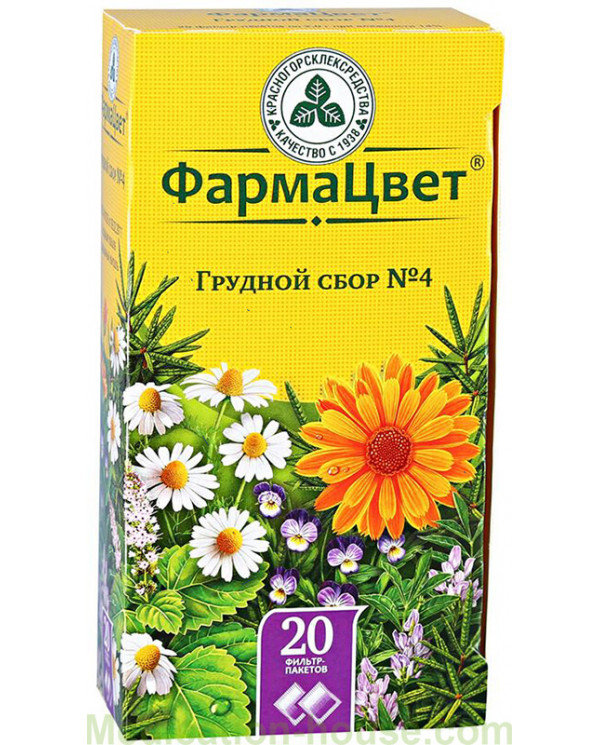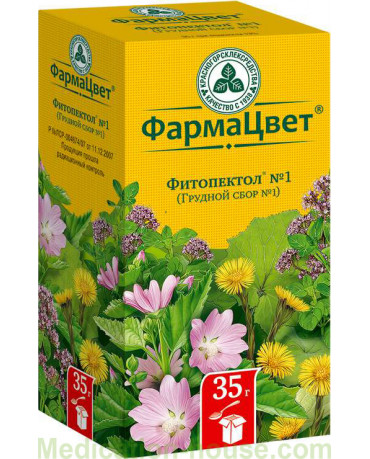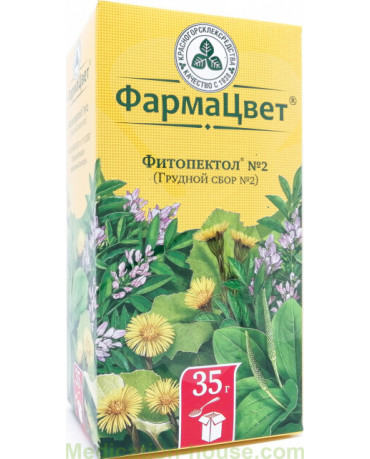Breast collection #4 instruction
You can buy Breast collection #4 here
The medication is produced by the Russian pharmaceutical company KrasnogorskLekstvo, specializing in the manufacture of herbs and fees. The manufacturer supplies drugs to the market for the treatment of inflammatory diseases of the upper and lower respiratory tract, genitourinary system, digestive problems, drugs for the treatment of chronic heart failure with edema, gallstone disease, cholecystitis, cardialgia. Herbs for brewing infusions for acute respiratory viral infections and colds are widely used.
One of the indications for treatment with Breast collection No. 4 is a cough for obstructive diseases of the respiratory system, including bronchial asthma and COPD. Bronchial asthma is a chronically occurring disease in the development of which various cellular elements participate, to a greater extent eosinophils and mediators of inflammation and allergies. The main link in pathogenesis is the narrowing of the lumen of the bronchi, which occurs due to the body's response to interaction with a specific allergen. The incidence varies in sources, up to ten percent of the world's population. In children is more common. There are risk factors for developing the disease:
Genetic predisposition. In almost half of patients, the disease is hereditary. As a rule, in a patient, one of the parents has asthma.
Occupational Exposure Factors. Technical dust, harmful gases have a great influence on the development of bronchial asthma, damaging the mucous membranes of the respiratory tract or acting as allergens.
Ecology. As you know, in Cuba, New Zealand and England, the incidence is much higher and exceeds the rates of other countries of the world. This is due to the increased content of allergens in the environment.
Food.
Household agents, including detergents containing highly active allergens.
Microbial agents.
Lack of exercise and obesity.
Symptoms of pathology can be minor and occur several times a month, and can make themselves felt every day and even at night. The main manifestations:
Dyspnoea, shortness of breath on exhalation, asthma attacks. The patient can take the so-called forced position - sitting, resting his hands on a hard surface. This facilitates the flow of air through the bronchial tree and slightly muffles the symptoms of suffocation. Due to the hard work of the main respiratory muscle of the diaphragm, the patient may feel pain in the chest. During the attack, a bluish tint of the lips, fingertips, palpitations, drowsiness can be observed.
Wheezing wheezing that is heard during auscultation of the lungs, and sometimes at a distance.
Coughing cough that does not bring relief.
To differentiate the diagnosis with other pathologies, it is important to identify the connection between the development of symptoms and exposure to allergens, seasonal exacerbations and the presence of parents or other relatives with a diagnosis of bronchial asthma. To confirm the diagnosis, additional methods of laboratory and instrumental diagnostics are used, as well as an assessment of the function of external respiration and the volume of forced expiration, based on which the stage of the disease is specified and the stage of treatment is prescribed. The first stage is characterized by rare and short episodes of the disease with a forced expiratory volume exceeding eighty percent. There are practically no night attacks. At the second stage, asthma is disturbed more than once a week, sleep and the rhythm of life may be disturbed, nighttime symptoms are possible twice in thirty days. The forced expiratory volume is reduced to less than eighty percent. In the third stage, the attacks are daily, the normal rhythm of life worsens due to the disease, at night the attacks are more often disturbed than once every seven days. The forced expiratory volume drops to 60-80. With severe asthma at the fourth stage, night attacks often disturb the patient, the symptoms are severe and difficult to stop, the function of external respiration is reduced to sixty percent or less.
In the treatment of bronchial asthma, the elimination of the allergen is important. In addition, pathogenetic and symptomatic drugs, a special diet, and a regimen of limited physical activity are prescribed. Perhaps the use of allergen-specific immunotherapy.
Pharmacological group
Breast collection No. 4 is a herbal remedy with anti-inflammatory, expectorant and bronchodilating effects. It is used mainly at the outpatient stage in both adults and children.
Release form and component composition
Available in the form of crushed vegetable dried raw materials, packaged in paper bags, convenient for brewing. The total number of bags in a package is ten or twenty, depending on the form of release.
In the box with the drug there is an instruction for use with all the necessary recommendations.
The composition of the medication includes several active pharmaceutical substances - flowers of a pharmacy chamomile containing flavonoids, chopped shoots of rosemary, marigold flowers, medicinal violet grass twenty percent, licorice root fifteen percent, mint five percent. In addition, the composition of the drug includes a small amount of additional substances necessary to give the dosage form in the form of plant materials for the preparation of infusion.
Pharmacological action and pharmacokinetic parameters of a herbal drug
Breast collection No. 4 contains a large number of active pharmaceutical substances. Infusion of medicinal chamomile has anti-inflammatory, antispasmodic and antibacterial effect, improves the digestive system. Infusion of dried Ledum has an expectorant effect, helps to reduce high blood pressure. Calendula has an antiseptic, wound healing, choleretic and sedative effect on the body. Improves the functioning of the heart and nervous system. Violet herbs complement the complex anti-inflammatory effect of herbal infusion. Licorice root restores overall tone, reduces swelling, temperature. Mint has an analgesic effect.
There is no data on the pharmacokinetic parameters of the drug, due to its multicomponent nature. Activity is due to the action of all components.
Indications for the use of the medication
The drug is used for:
Bronchial asthma and obstructive diseases of the bronchial tree to relieve symptoms, to achieve an expectorant effect.
Acute inflammatory process in the larynx, trachea.
An acute inflammatory process in the upper respiratory tract.
Acute inflammation in the bronchial tree, accompanied by a cough.
Coughing.
Range of contraindications for the reception of herbal collection for the preparation of infusion
Do not use the medication for:
Increased individual sensitivity to the main pharmaceutical substances, as well as additional substances necessary for giving the dosage form in the form of a collection of herbs, packaged in filter bags.
Pathologies of the kidneys with a glomerular filtration rate by Reberg's test of less than 30 milliliters per minute.
Pathologies of the liver, having class B and C on the Child-Pugh scale.
Treatment of children under the age of six months.
With caution, under the constant supervision of a specialist, to use in the treatment of patients with active forms of the disease caused by mycobacterium tuberculosis, fungal, viral and bacterial pathogens, in the treatment of respiratory pathologies, decompensated liver cirrhosis.
Side effect of the drug Breast collection No. 4, which relieves cough symptoms
Undesirable effects are possible, such as:
Allergic reactions in the form of a rash, accompanied by itching or without it, redness of the skin, angioedema, rarely - anaphylactic shock.
Dyspeptic symptoms in the form of nausea, vomiting, pain in the stomach or intestines, constipation, frequent loose stools, digestive disorders of a functional nature, excessive accumulation of gases in the intestines.
Headache of various localization and severity.
Weakness, drowsiness, apathy, syndrome of internal anxiety, feelings of discomfort.
If side effects occur, you must consult a specialist to resolve the issue of further use of the medication.
The use of Breast collection No. 4: method, features, dose
Before use, it is necessary to consult a specialist, carefully read the instructions again, take into account indications and contraindications. The dosage is selected individually at an appointment with the attending physician. To prepare the infusion, four grams of the herbal mixture is added to the mug and poured with boiling water, insisted for about an hour, filtered through a strainer. Then you need to add boiling water to two hundred milliliters of liquid. Take a third glass three times a day. The course of treatment is up to three weeks. Children under three years old are given a tablespoon of broth, children from three to ten years old - two tablespoons, children over ten - a full dosage, as for an adult.
Special instructions when using the product
In pediatrics, the drug is used, the effects of the drug on children older than six months have been studied enough. Use in children up to six months is impractical. For elderly patients, dosage reduction is not required. In case of impaired renal function while maintaining a glomerular filtration rate of more than 30 milliliters per minute, dose adjustment is not required. With class A liver pathologies, the Child-Pugh scale adjustment is not needed. In patients with more severe damage to these organs, collection of plants is contraindicated.
Use of the collection for the preparation of a decoction during pregnancy and until the termination of breastfeeding
The effects on the fetus are well understood. After consultation with the attending gynecologist, small dosages are possible. Preparation of the infusion described above.
Overdose
Instructions for use do not describe cases of taking doses in larger quantities than recommended at a consultation with a specialist or in recommendations for use. Symptoms similar to those from the paragraph on undesirable effects are possible: dyspeptic disorders in the form of nausea, vomiting, pain in the stomach and intestines, as well as allergic reactions to the components of the collection. The treatment is symptomatic. A medication of a specific action that stops or attenuates the effect of large doses taken (antidote) has not been developed. Dialysis is not used.
Concomitant use with other drugs and compatibility with alcoholic beverages
It is not recommended to be taken together with drugs of a similar effect. It is necessary to inform the doctor about all medicines that are regularly used, since there is a risk of weakening or strengthening the action of the main pharmaceutical substances. A complete list of drugs not recommended for use in conjunction with herbal collection is presented in the official instructions. Alcohol during the course of treatment is strictly prohibited.
Reviews about Breast collection number 4
According to reviews, Breast collection No. 4 helps with coughing, improves sputum discharge, and has an anti-inflammatory effect. Side effects are very rare. The drug is completely natural, does not contain artificial colors, flavors and preservatives. Filter bags are easy to brew and drink. The tool is inexpensive and affordable.
Of the shortcomings, most often patients note a specific taste of the infusion, which many do not like. The drug is not suitable for allergy sufferers, as it can cause allergic reactions. With severe coughing, the effect of treatment is not always noticeable.
Storage conditions
The drug requires optimal storage conditions, including items such as:
Compliance with dry temperatures up to thirty degrees.
Use before the expiration date of two years.
Inaccessibility for children.
After the expiration of the period do not apply.
Terms of sell
You can buy Breast collection #4 without a prescription.



